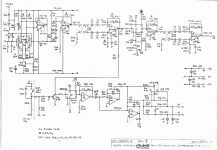Hi
My general understanding was after reading tons of stuff that tantalum capacitors aren't the best for output caps in the path.
After doing some more research Im now more confused as I think my knowledge is rusty.
I have this DAP that uses 2x 100uf 6v caps (see photo).
I can see that there is space I could easily use. What path I should go if I'd like to do small upgrade?
1. Use nobium caps?
2. use electrolytic bipolar(won't fit larger than 22uf)?
3. use polarised electrolytic cap
4. add film/electrolytic/electrolytic bipolar cap as bypass?
Thanks,
doc
My general understanding was after reading tons of stuff that tantalum capacitors aren't the best for output caps in the path.
After doing some more research Im now more confused as I think my knowledge is rusty.
I have this DAP that uses 2x 100uf 6v caps (see photo).
I can see that there is space I could easily use. What path I should go if I'd like to do small upgrade?
1. Use nobium caps?
2. use electrolytic bipolar
3. use polarised electrolytic cap
4. add film/electrolytic/electrolytic bipolar cap as bypass?
Thanks,
doc
Attachments
Last edited:
Tants are excellent capacitors, properties like electrolytic for capacity and good hf pass like ceramic.
I would leave them alone unless faulty.
I would leave them alone unless faulty.
Thanks. Its not about the capacity that is the issue but potential disortion, these should be only blocking DC, right?Tants are excellent capacitors, properties like electrolytic for capacity and good hf pass like ceramic.
I would leave them alone unless faulty.
Tants have some weird linearity issues, but it usually doesn't matter. The general rule is, if the cap is large enough that no audio voltage appears across it, it can't affect the signal. These days there's few reasons to use them, as aluminum electrolytics have mostly caught up to the size advantage tants had. If you use a tantalum, it must never be exposed to reverse voltage of any amount, even briefly. They should also be derated by about 50%.
Sorry, not sure if I understand right the "audio voltage" part. These sit at headphone output to block DC offset going to headphones.Tants have some weird linearity issues, but it usually doesn't matter. The general rule is, if the cap is large enough that no audio voltage appears across it, it can't affect the signal. These days there's few reasons to use them, as aluminum electrolytics have mostly caught up to the size advantage tants had. If you use a tantalum, it must never be exposed to reverse voltage of any amount, even briefly. They should also be derated by about 50%.
I know about the safety of using tants but for now I'm considering replacing them with different type rather than installing another tants.
Thanks and sorry if my question are noobish. It's because I am noob 🙂
The function of the capacitor here is to block DC and let the AC (the audio) pass though.Sorry, not sure if I understand right the "audio voltage" part. These sit at headphone output to block DC offset going to headphones.
I know about the safety of using tants but for now I'm considering replacing them with different type rather than installing another tants.
Thanks and sorry if my question are noobish. It's because I am noob 🙂
Optimally the capacitor should be considered as a short for the AC - but in reality there will always be a small AC voltage across the capacitor.
The amount of AC voltage across the capacitor depends on the frequency, the capacitor size and the current though the capacitor.
The larger the capacitor - the smaller the AC voltage across the capacitor will be.
The distortion caused by the capacitor relates to the AC voltage across the capacitor - and the lower the AC voltage across the capacitor the less the distortion caused by the capacitor will have an impact on the total signal.
Cheers, Martin
Thanks Martin,The function of the capacitor here is to block DC and let the AC (the audio) pass though.
Optimally the capacitor should be considered as a short for the AC - but in reality there will always be a small AC voltage across the capacitor.
The amount of AC voltage across the capacitor depends on the frequency, the capacitor size and the current though the capacitor.
The larger the capacitor - the smaller the AC voltage across the capacitor will be.
The distortion caused by the capacitor relates to the AC voltage across the capacitor - and the lower the AC voltage across the capacitor the less the distortion caused by the capacitor will have an impact on the total signal.
Cheers, Martin
I get why the caps are installed there - to block the DC. That is not my question.
I'm asking if the tantalum capacitor installed in that place is the most optimal (in terms of sound quality) option considering that I can install same value of 100uf or bypass with small cap. During my cMoy building times the tant were always considered as no-no on the audio path. But then this was >10 years ago.
Thanks for the explanation. Still no answer to my question.This was an explanation about the "audio voltage" part which you wrote you did not understand.
I understand from above that the tants might have better DC blocking capabilities but I'm asking the question with sound quality in mind - yes, I know that DC can be causing the dissortion but lets assume that the DC offset is marginal and caps are there just for headphone safety.
Thank you.
I'm not sure anybody can give a definitive answer. "No audio voltage across it" means if you ignore the DC, the audio signal on one side of the cap is identical to the signal on the other side. That's also what you'd get with a piece of wire, ignoring DC of course. If the cap is large enough and has a low enough esr, that should be the case. If you achieve that, it doesn't matter what kind of cap you use, it shouldn't affect the sound. Personally, I'm of two minds. I don't like tantalums in audio equipment because big ones are expensive and they need to be derated. I don't trust them for SQ. OTOH, when I don't ever want to replace a cap again, say in my test equipment, I use a properly selected tantalum, knowing it will probably outlive me.
Measure the DC voltage on the caps input, if it's only few mV then it is not really optimal for a polarised cap to be used here, it could benefit from replacing it with bipolar cap, nichicon ES bipolar electrolytics are made for audio with low measured distortion.
You can use this sim to see the response of a given bypass cap for a given headphone load i.e this is where you will potentially hear the effect of the bypass.
Space will of course be the limiting factor for bypass cap value.
Don't know if it'll make a positive difference but If you are going to replace the tantalums you may aswell try it.
Check if there is a series resistor on the output of op amp, I would expect there to be one but if not then adding caps with lower ESR may impact stability of the op amp due to headphone cable capacitance, if it doesn't oscillate it could still result in an 'edgier' sound, easily mistaken for increased 'clarity'.
100u seems like an unusually small cap value for typical headphone loads, bass would be rolled off with lower impedance headphones (again, check sim), you might want to replace it with a higher value.
If there is only a couple mV of DC you might also be able to just bypass the cap completely, but obviously you would be giving up that last layer of protection for your headphones in unlikely event that it malfunctions and outputs DC.
Also possible that the cap is there to filter out turn-on/off thumps, maybe that's why it's so undersized.
You can use this sim to see the response of a given bypass cap for a given headphone load i.e this is where you will potentially hear the effect of the bypass.
Space will of course be the limiting factor for bypass cap value.
Don't know if it'll make a positive difference but If you are going to replace the tantalums you may aswell try it.
Check if there is a series resistor on the output of op amp, I would expect there to be one but if not then adding caps with lower ESR may impact stability of the op amp due to headphone cable capacitance, if it doesn't oscillate it could still result in an 'edgier' sound, easily mistaken for increased 'clarity'.
100u seems like an unusually small cap value for typical headphone loads, bass would be rolled off with lower impedance headphones (again, check sim), you might want to replace it with a higher value.
If there is only a couple mV of DC you might also be able to just bypass the cap completely, but obviously you would be giving up that last layer of protection for your headphones in unlikely event that it malfunctions and outputs DC.
Also possible that the cap is there to filter out turn-on/off thumps, maybe that's why it's so undersized.
Thank you all,
I'll try some of the configurations after checking the DC offset first. At the end of the day my ears should be the best judge.
I'll try some of the configurations after checking the DC offset first. At the end of the day my ears should be the best judge.
I have been re-appreciating Tantalum capacitors (radial 'drop' types) instead of aluminium electrolytics, using them in signal coupling and cathode bypass duties.
But, not alone!
In parallel with film caps and/or paper in oil types.
After several auditions, they seem to offer an improvement in place of electrolytics in parallel with the above.
In particular, they add a bit more definition in mids/highs and offer a slight improvement in imaging accuracy.
To my ears at least.
But, not alone!
In parallel with film caps and/or paper in oil types.
After several auditions, they seem to offer an improvement in place of electrolytics in parallel with the above.
In particular, they add a bit more definition in mids/highs and offer a slight improvement in imaging accuracy.
To my ears at least.
Member
Joined 2009
Paid Member
I've used Tants in a couple of amps, especially those based on old NAIM circuits and so far I am also quite happy with them.
Yes, thank you.
I have this in mind.
I'm using 25VDC rated Tantalums as input capacitors, in front of opamps and with almost zero DC and 10VDC rated ones as cathode bypass capacitors at roughly 1VDC bias.
I suppose it is OK.
I have this in mind.
I'm using 25VDC rated Tantalums as input capacitors, in front of opamps and with almost zero DC and 10VDC rated ones as cathode bypass capacitors at roughly 1VDC bias.
I suppose it is OK.
Actually your question was answered. But it seems your understanding of capacitors is backwards.Thanks for the explanation. Still no answer to my question.
I understand from above that the tants might have better DC blocking capabilities but I'm asking the question with sound quality in mind - yes, I know that DC can be causing the dissortion but lets assume that the DC offset is marginal and caps are there just for headphone safety.
All capacitors block DC. All of them. There's no "better DC blocking capabilities" of one cap over the other. Granted, some dielectric types may have higher leakage current, but unless the capacitor is faulty that doesn't affect the performance of the capacitor when used as an output cap in an audio amp.
DC voltage on a capacitor doesn't cause distortion. Changes in the capacitance as function of the applied AC signal causes distortion. Minimizing the AC signal across the capacitor minimizes the distortion of the capacitor. It's pretty easy to minimize the AC signal across a capacitor: Simply choose the largest capacitor you can fit (or that's large enough to drive the distortion down to an acceptable level).
Tom
Nichicon muse bipolars have 4...6 times higher esr than some varietes of Panasonic bipolars.That doesn't mesn anything bad because most headphones are inductive in nature so it helps at artenuating resonances to have a small r in series with an LC circuit, besides headphobes resistance being much larger R than cap's have their ESL.
As for the output value of a capacitance for the minimum frequency pass it all depends on headphones impedance.My 250 ohms ones don't feel any bad bass with 22uF output caps.Bipolars despite having lower esr than unipolar caps provide lower leakage current in the wet electrolite variety and fake wet nichicons have so bad leakage that I had to throw them away so the source of your capacitors is important.I heard people having flamable experiences with tantalum.I didn't, but then there's also the sanyo oscon variety solid polymer or any other solid polymer.
For high signal pass i'd take bipolars anytime.
First SSL 4000e recording mixers used two series tantalum with dc bias for low signal pass.It seems they reported dead shorted caps but that happened after 30 or 40 years of use with probably not the best quality tantalums.I find tantalum caps in very expensive scientific and medical equipment found in the region of 1...2 million euros pricetag...and never have seen a bad tantalum in them so probably some are better than others.
https://gearspace.com/board/high-end/1027456-ssl-4000-e-basic-maintenance.html
As for the output value of a capacitance for the minimum frequency pass it all depends on headphones impedance.My 250 ohms ones don't feel any bad bass with 22uF output caps.Bipolars despite having lower esr than unipolar caps provide lower leakage current in the wet electrolite variety and fake wet nichicons have so bad leakage that I had to throw them away so the source of your capacitors is important.I heard people having flamable experiences with tantalum.I didn't, but then there's also the sanyo oscon variety solid polymer or any other solid polymer.
For high signal pass i'd take bipolars anytime.
First SSL 4000e recording mixers used two series tantalum with dc bias for low signal pass.It seems they reported dead shorted caps but that happened after 30 or 40 years of use with probably not the best quality tantalums.I find tantalum caps in very expensive scientific and medical equipment found in the region of 1...2 million euros pricetag...and never have seen a bad tantalum in them so probably some are better than others.
https://gearspace.com/board/high-end/1027456-ssl-4000-e-basic-maintenance.html
Attachments
Exactly this. Old drop type tantalums are to be avoided/replaced as they are the ones that caused the bad reputation and also they are often indeed faulty or near faulty.I find tantalum caps in very expensive scientific and medical equipment found in the region of 1...2 million euros pricetag...and never have seen a bad tantalum in them so probably some are better than others.
The drop types can cause spectacular fireworks when used directly on rails while I don't do anything else with modern tantalum caps.
- Home
- Design & Build
- Parts
- Tantalum capacitor in audio path


